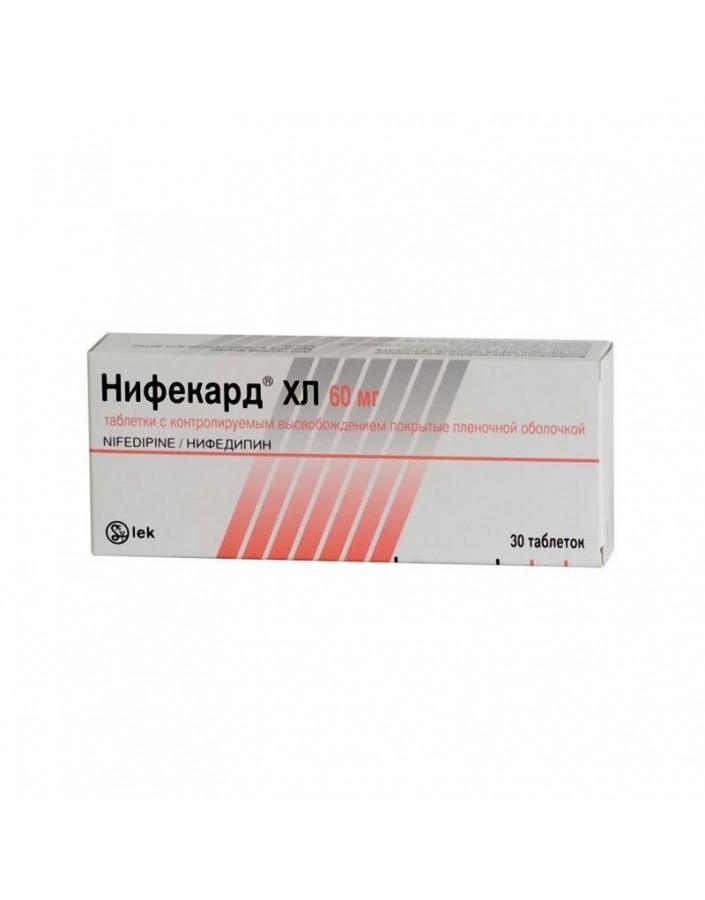




Security policy (edit with Customer reassurance module)

Delivery policy (edit with Customer reassurance module)

Return policy (edit with Customer reassurance module)
Controlled release tablets
1 pill of controlled release contains 60 mg of Nifedipine.
30 pieces
Nifedipine is a dihydropyridine derivative. The mechanism of action is the blockade of slow Calcium channels.
Inhibits the transport of calcium ions through the membranes of myocardial cells or vascular smooth muscle cells, without affecting plasma calcium concentrations. The result of this action is the dilatation of arteries and arterioles, a decrease in peripheral vascular resistance and, as a consequence, a decrease in blood pressure. Nifedipine causes dilatation of the main coronary arteries and arterioles in both normal and ischemic areas of the myocardium, and prevents spasm of the coronary arteries.
Nifedipine increases the supply of myocardium with oxygen while reducing the need for oxygen, which allows the use of the drug for the treatment of angina.
Arterial hypertension
Coronary disease:
- stable angina,
- vasospastic stenocardia (Prinzmetala).
Hypotension.
Severe aortic stenosis.
Obstructive cardiomyopathy.
Porphyria.
Hypersensitivity to nifedipine.
Nifedipine is not prescribed for cardiogenic shock with residual angina pectoris (the risk of myocardial infarction). Caution is prescribed to patients with congestive heart failure, abnormal liver function and diabetes.
For patients with severe obstructive coronary disease, there is a risk of an increase in the frequency, severity of manifestations and duration of strokes after nifedipine. In this case
requires the abolition of the drug.
There are no data on the safety of using nifedipine during pregnancy, so the prescription of nifedipine to pregnant women is indicated only if the possible effect of taking the drug outweighs the possible risk to the fetus.
Nifedipine passes into breast milk, so the drug is not prescribed during lactation.
Simultaneous administration of nifedipine and fentanyl can cause severe hypotension, therefore, it is recommended that nifedipine be removed at least 36 hours before anesthesia (if possible).
When nifedipine is combined with antihypertensive drugs, nitrates and tricyclic antidepressants, the hypotensive effect is enhanced.
With simultaneous appointment with beta-blockers, along with increased hypotensive action, heart failure may develop in some cases.
Combinations of nifedipine with cardiac glycosides with theophylline are usually well tolerated by patients; in very rare cases, there may be an increase in the level of Digoxin and theophylline in the blood plasma.
The combined use of nifedipine and cimetidine (to a lesser extent, ranitidine) can lead to an increase in the level of nifedipine in the blood plasma.
In individual cases, the combination of nifedipine and quinidine, when taken orally, decreases the concentration of quinidine in the blood plasma.
An overdose of nifedipine causes peripheral vasodilation with severe and possibly prolonged systemic hypotension.
Treatment of overdose is to remove the drug from the body and carefully monitor vital functions, heart activity, lungs and the excretory system. The clearance of nifedipine is increased in patients with liver failure. Due to the high degree of binding to plasma proteins, hemodialysis is not effective.
Store at a temperature not higher than 25oWITH.